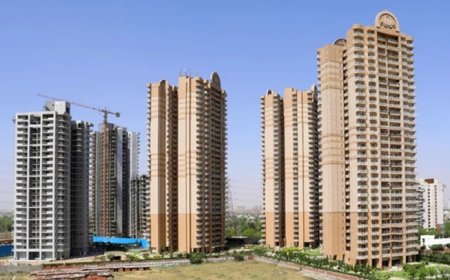What’s the Difference Between Furnished and Unfurnished Apartments?
This choice can affect everything from your budget and lifestyle to how much flexibility you have. Understanding the difference between the two is essential, especially in competitive markets like Doha and other cities across Qatar. Here's a detailed breakdown of what sets them apart and what you need to consider when making your choice.
Definition and Basic Features
Think of essentials like beds, sofas, dining tables, chairs, wardrobes, and often kitchen appliances like a refrigerator, oven, microwave, and sometimes even small appliances like kettles or toasters. Some furnished apartments may even come with linens, dishes, and cutlery.
An unfurnished apartment, on the other hand, usually comes bare. At most, youll get basic fittings like lighting, kitchen cabinets, and bathroom fixtures. In many cases, youll need to bring everything else, including major appliances like a washing machine and refrigerator. This means more upfront investment, but also more freedom to customize your space.
Cost Considerations
Rent for furnished apartments tends to be higher than for unfurnished units. This makes senselandlords incur more costs to furnish the place and typically factor that into the monthly rent. However, the higher rent might save you the large upfront cost of buying furniture and appliances.
Unfurnished apartments usually have lower monthly rents. If you already own furniture or plan to stay long-term, it might be the more cost-effective option in the long run. But you need to factor in the initial expense of buying furnishings, as well as the hassle and cost of moving them if you relocate.
Flexibility and Lifestyle
Furnished apartments offer a turn-key solution. They're perfect for expats, students, and professionals on short-term contracts who want a simple, hassle-free move-in experience. You dont have to worry about setting up a home from scratch, and moving out is easyjust pack your personal items and go.
In contrast, unfurnished apartments appeal to long-term residents or families who want to make a place feel like home. With an unfurnished space, you have complete control over the dcor, layout, and feel of your home. This is ideal if you want consistency or plan to stay for several years.
Lease Terms and Market Dynamics
In Doha, the availability of furnished versus unfurnished apartments often varies by neighborhood and market trends. For example, areas like West Bay and The Pearl are known for offering premium, fully furnished units targeted at international tenants and corporate renters. On the other hand, suburban areas and traditional neighborhoods might lean toward unfurnished units aimed at families or long-term residents.
Landlords may also adjust lease terms based on furnishing. Furnished apartments usually come with shorter lease durations or more flexible terms, while unfurnished properties often require longer commitments. This can impact your decision depending on how long you plan to stay in a particular location.
Maintenance and Wear-and-Tear
One of the downsides of renting a furnished apartment is dealing with maintenance responsibilities for items you didnt purchase. Tenants may be held accountable for damage to furniture or appliances, even if it's just from regular use. That means you might be on the hook for a worn-out sofa or a broken toaster that was never yours to begin with.
In unfurnished apartments, since you own most of whats inside, you have full control over maintenance and replacement. You know the condition of your belongings, and you're not liable for items provided by a landlordbecause there usually arent any.
Moving and Setup
There's no need to coordinate the delivery of a bed, dining table, or sofa. Its ideal for those who value convenience or need to relocate quickly for work or other obligations.
Moving into an unfurnished apartment is a bigger project. But once youre done, its your spacedesigned exactly how you want it.
Security Deposits and Insurance
Furnished apartments often come with higher security deposits to cover potential damage to furniture or appliances. Landlords want to protect their investment. You may also be encouraged or required to take out renters insurance that covers damage to the furnishings.
Unfurnished apartments usually involve a standard deposit, often equivalent to one or two months rent. Since theres less to damage that belongs to the landlord, theres generally less financial liability, aside from structural elements of the apartment itself.
Target Tenants and Market Demand
The type of apartment you choose should align with your situation. Furnished units are geared toward expats, diplomats, students, and business professionalspeople who prioritize convenience and temporary stays. In markets like Qatar, especially in business hubs such as Doha, many property listings cater to this demographic due to high demand for move-in-ready homes.
Unfurnished apartments are typically targeted at residents who are rooted in the cityfamilies, long-term employees, and people who see the rental as a semi-permanent home. In these cases, the ability to customize and furnish according to personal taste outweighs the convenience of a pre-furnished unit.
Interior Aesthetic and Customization
A big benefit of unfurnished apartments is the ability to personalize your home. You can choose pieces that match your style, whether minimalist, traditional, or modern. The freedom to decorate as you wish makes it feel more like your own space.
Some landlords maintain neutral palettes to appeal to the widest audience, which can feel bland or uninspiring. While some high-end furnished apartments offer designer interiors, that usually comes with a premium price tag.
For tenants focused on creating a unique or aesthetically curated space, an unfurnished unit provides a blank canvas.
Location and Investment Impact
The type of furnishing can also influence property investment strategy. Investors targeting short-term rental income may opt to furnish their properties to attract transient renters. Furnished units generally yield higher returns per month but may come with higher turnover and maintenance costs. Property management plays a crucial role here by helping landlords maintain furniture and tenant satisfaction.
For landlords targeting long-term rental income, unfurnished properties offer more stability. With longer leases and less wear-and-tear on interiors, the management workload is often lower.
To explore various housing options, especially in fast-growing markets like Doha, consider browsing listings for apartments for rent in Doha to find the right fit for your needs.
Conclusion
The difference between furnished and unfurnished apartments boils down to cost, convenience, and lifestyle. Furnished apartments offer immediate comfort and ease, ideal for short stays or people on the move. Unfurnished apartments provide flexibility, customization, and better long-term value for those settling down.
Choosing between the two isnt just about what comes with the apartmentits about how you plan to live in it. Consider your lifestyle, budget, and how long you plan to stay. Whether you're a first-time renter or relocating internationally, making the right choice can define your comfort, freedom, and financial outcomes.
For those navigating the real estate landscape in Qatar, particularly Doha, understanding these differences is key to making a smart rental decision in a fast-changing housing market.
















![Top 9 Real Estate Mobile App Developers in Riyadh, Saudi Arabia [2025 Edition]](https://www.biphoo.uk/uploads/images/202507/image_430x256_6879d0d524335.jpg)

















